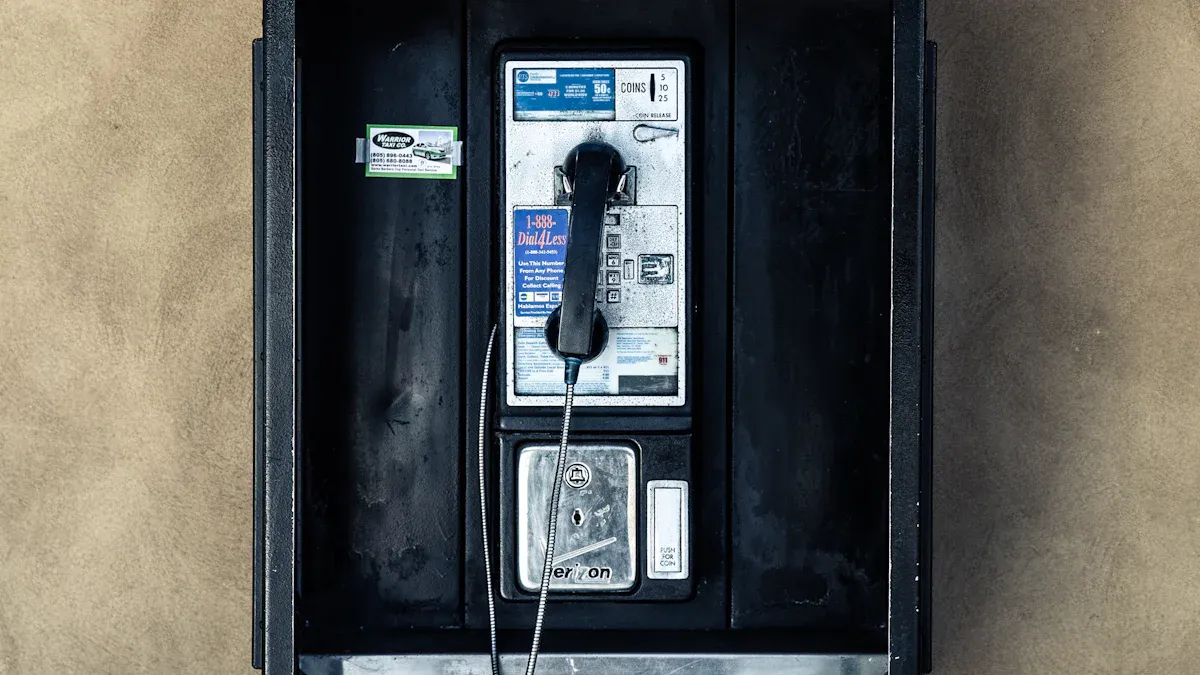
Outdoor telephones play a vital role in keeping people connected, especially in remote or public areas. However, harsh weather can damage these devices. A waterproof outdoor telephone or a public outdoor telephone must withstand rain, snow, and heat. Protecting them ensures reliable communication, whether for emergencies or as a public security telephone.
Protecting Outdoor Telephones from Extreme Cold

Use Insulated Enclosures to Retain Heat
Insulated enclosures are a game-changer for outdoor telephones in freezing conditions. These enclosures use advanced materials, like phase change materials (PCMs), to regulate temperature. During the day, they absorb heat to prevent the interior from overheating. At night, they release stored energy to maintain a stable temperature. This keeps the telephone’s components safe and functional, even when the weather outside is harsh.
Install Heating Elements for Consistent Temperature
Adding heating elements inside the enclosure can help maintain a consistent temperature. These elements ensure that the telephone stays warm enough to operate smoothly, even during extreme cold spells. This is especially useful in areas where temperatures drop below freezing for extended periods.
Avoid Direct Exposure to Freezing Temperatures
Placing outdoor telephones in sheltered locations can make a big difference. Install them under awnings, inside kiosks, or in areas protected from the wind. This reduces their exposure to freezing temperatures and prevents frost from forming on the device.
Gradually Warm Devices to Prevent Battery Damage
Cold weather can wreak havoc on lithium-ion batteries. The molecules inside the battery shrink, which can lead to malfunctions. To avoid damage, gradually warm the device before use. Let it thaw at room temperature instead of using heaters or direct heat, which can harm the battery.
Regularly Inspect for Ice or Snow Accumulation
Ice and snow can block buttons, displays, or even the speaker of an outdoor telephone. Regular inspections help identify and remove any buildup before it causes problems. A quick check after a snowstorm can go a long way in keeping the device functional.
Preventing Overheating in Outdoor Telephones
Install Shade Covers or Canopies
Shade covers or canopies are excellent for reducing heat exposure. They block direct sunlight, keeping outdoor telephones cooler. According to the EPA, shading systems like awnings can cut solar heat gain by up to 65% on south-facing surfaces and 77% on west-facing ones. These covers not only protect the device but also contribute to energy efficiency. Options like patio awnings or solar screens are easy to install and highly effective in minimizing heat absorption.
Use Heat-Resistant Materials for Casings
Heat-resistant materials are essential for outdoor telephones in hot climates. These materials undergo rigorous testing, including thermal modeling and direct experiments, to ensure they can handle extreme temperatures. By using casings made from such materials, the device remains functional even during heatwaves. This approach also prevents warping or damage caused by prolonged exposure to high temperatures.
Ensure Proper Ventilation to Prevent Heat Build-Up
Good ventilation is key to avoiding overheating. Vents or perforations in the casing allow hot air to escape, keeping the internal components cool. Without proper airflow, heat can build up inside the device, leading to malfunctions. Regularly checking and cleaning these vents ensures they remain effective.
Position Telephones Away from Direct Sunlight
Placing outdoor telephones in shaded or less sunny areas can make a big difference. Locations under trees, overhangs, or other structures reduce direct exposure to the sun. This simple step helps maintain a stable temperature and extends the device’s lifespan.
Activate Battery-Saving Modes in High Temperatures
High temperatures can drain batteries faster. Many outdoor telephones come with battery-saving modes that reduce power consumption. Activating these features during hot weather helps the device run efficiently while protecting the battery from overheating.
Safeguarding Outdoor Telephones Against Rain and Moisture

Use Waterproof Casings and Seals
Waterproof casings are essential for keeping an outdoor telephone safe from rain and moisture. These casings create a barrier that prevents water from seeping into the device. High-quality seals around openings, like the keypad or speaker, add an extra layer of protection. When choosing a casing, look for one with an IP rating of at least IP65. This ensures the device can withstand heavy rain without compromising its functionality.
Install Proper Drainage Systems to Prevent Water Accumulation
Water pooling around an outdoor telephone can lead to long-term damage. Installing a drainage system helps direct water away from the device. For example, sloped surfaces or small drainage holes at the base of the enclosure can prevent water from collecting. This simple step can significantly reduce the risk of moisture-related issues.
Apply Anti-Corrosion Coatings to Metal Components
Metal parts, like screws or brackets, are prone to rust when exposed to moisture. Anti-corrosion coatings act as a shield, protecting these components from rust and wear. Regularly applying these coatings ensures the device remains durable, even in wet conditions.
Conduct Regular Maintenance to Check for Leaks or Damage
Routine maintenance is key to spotting potential problems early. Inspect the casing, seals, and drainage system for any signs of wear or damage. If you notice cracks or leaks, address them immediately to prevent water from entering the device. A quick monthly check can save you from costly repairs later.
Update Software to Enhance Weather Resistance
Some outdoor telephones come with software that improves their weather resistance. For instance, updates may include features that optimize performance in humid conditions. Keeping the software up to date ensures the device operates efficiently, even during heavy rain.
General Maintenance Tips for Outdoor Telephones
Schedule Routine Inspections and Cleaning
Regular inspections keep outdoor telephones in top shape. Dust, dirt, and debris can accumulate over time, affecting performance. A quick wipe-down with a soft cloth and a non-abrasive cleaner removes grime and prevents buildup. Scheduling monthly checks ensures any hidden issues, like loose parts or minor cracks, are caught early. This simple habit saves time and money in the long run.
Replace Worn or Damaged Components Promptly
Worn-out parts can lead to bigger problems if ignored. Buttons, screens, or wiring may wear down due to constant use or exposure to the elements. Replacing these components as soon as they show signs of damage keeps the device functional. It also prevents small issues from escalating into costly repairs.
Use Weather-Resistant Materials for Long-Term Durability
Weather-resistant materials are a must for outdoor telephones. Casings made from stainless steel or polycarbonate resist rust, UV rays, and impact. These materials extend the device’s lifespan and reduce the need for frequent replacements. Investing in durable materials upfront pays off over time.
Train Staff on Proper Maintenance Practices
Staff members play a key role in maintaining outdoor telephones. Training them on cleaning techniques, inspection routines, and basic troubleshooting ensures the devices stay in good condition. A well-informed team can quickly address minor issues before they become major problems.
Store Devices in Controlled Environments When Not in Use
When outdoor telephones aren’t in use, storing them in a controlled environment protects them from unnecessary wear. A dry, temperature-regulated space prevents damage caused by extreme weather. This practice is especially useful for seasonal installations or backup devices.
Protecting an outdoor telephone from harsh weather ensures it stays reliable and lasts longer. Simple steps like using insulated enclosures, waterproof casings, and heat-resistant materials make a big difference. Regular inspections also help catch issues early. By following these tips, anyone can keep their outdoor telephones working in any weather. 🌦️
FAQ
How often should outdoor telephones be inspected?
Inspect outdoor telephones at least once a month. Regular checks help identify issues like cracks, leaks, or dirt buildup before they cause major problems.
Can outdoor telephones survive extreme weather without additional protection?
Most outdoor telephones need extra protection, like waterproof casings or insulated enclosures, to handle extreme weather. These measures ensure durability and reliable performance in harsh conditions.
What is the best material for outdoor telephone casings?
Polycarbonate and stainless steel are excellent choices. They resist rust, UV rays, and impact, making them ideal for long-term outdoor use. 🌟


